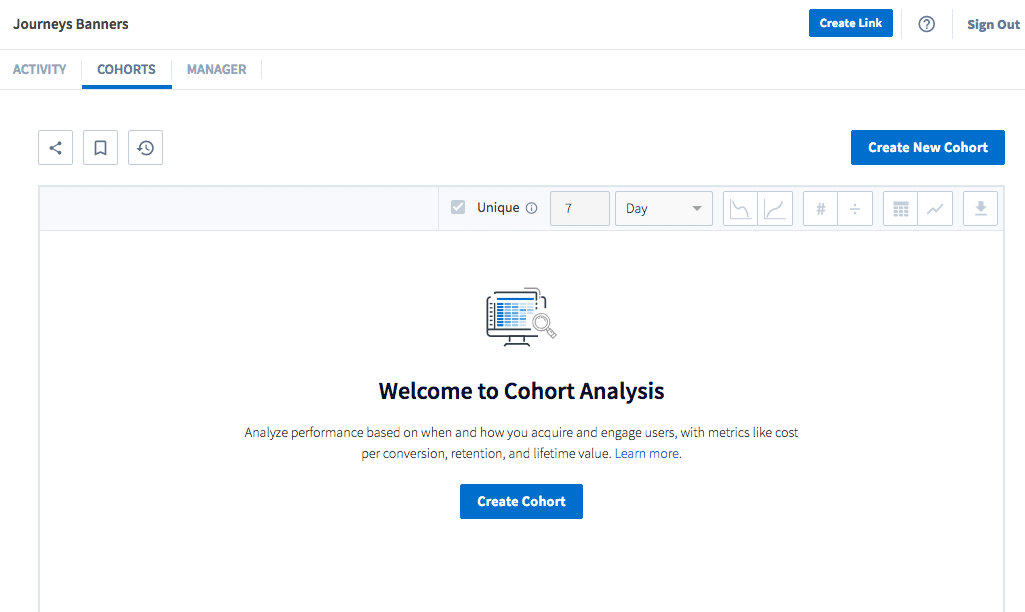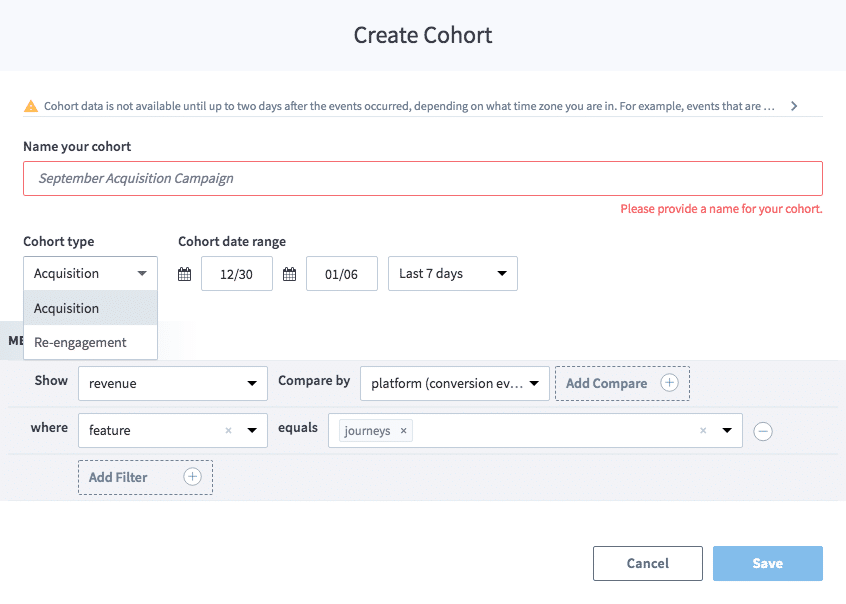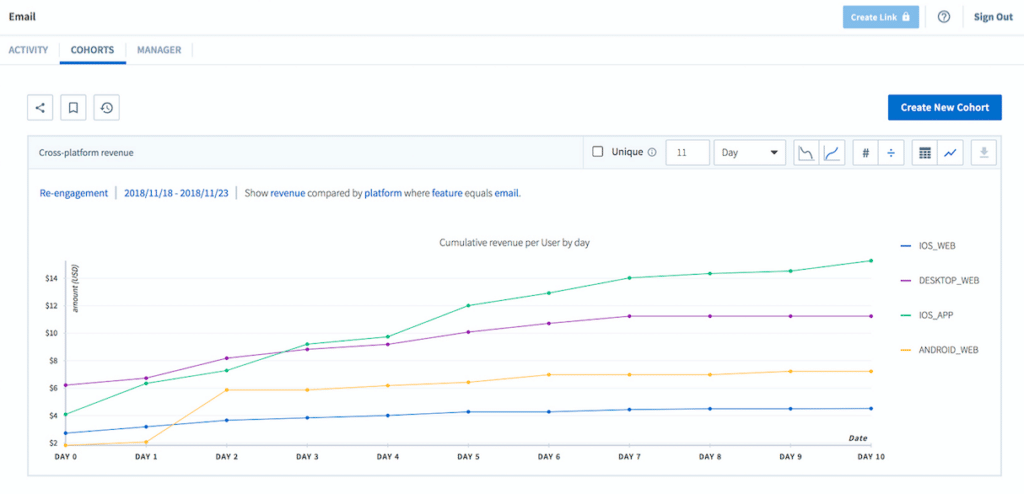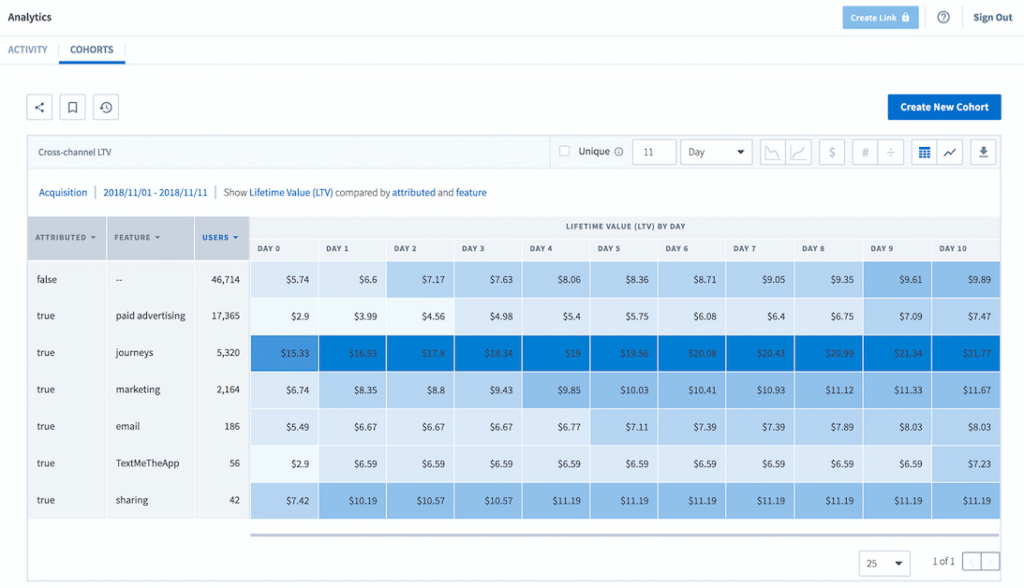Whenever we decide to prioritize a new product feature at Branch, we ask ourselves a lot of questions. First and foremost: How will this help our existing and future customers achieve their mobile goals?
In the app and mobile marketing space, “help” can take many forms. It can mean enabling a brand like TBS/TNT to seamlessly deep link users into apps to watch leading programs or ensuring a company like Checkout 51 can deep link into its app from paid ads, driving more revenue and ROI. It can also mean ensuring global brands that implement Branch’s deep links across every channel can accurately attribute their paid and organic efforts to achieve a full-funnel view of the customer journey.
When we began our quest to deliver the industry’s leading cohort analysis solution, we asked a bigger question: From a data standpoint, how can understanding end-user behaviors over time affect how marketers analyze marketing campaign performance?
In a world where legacy providers report on isolated channels and events, our vision of a holistic, cross-channel solution represents a significant leap forward. The primary reason is that no single data point can fully reflect the wide range of user interactions across multiple channels like paid ads, emails, and mobile web banners.
Unless marketers are aware of how relationships impact revenue over time, they’ll be unable to understand and analyze the long-term, multi-platform, high-LTV relationships that matter most. That’s where cohort analysis enters the picture.
What Is a Cohort? And Why Does It Matter?
Before we dive into Branch’s cohort analysis and how you can use it, let’s take a quick step back and look at the origins of cohorting.
In data science, cohort analysis is the study of user groups based on related behaviors over time. Rather than counting each user as a single unit, grouping users according to commonality or shared characteristics allows researchers to assemble more granular behavior metrics and surface important insights.
In the context of marketing analytics, a cohort is a subset of users segmented by specific interactions with your properties (e.g. app/website) and campaigns (e.g. email/text), as well as select behaviors (i.e. the first time a user downloads your app, the first conversion, the second conversion, etc.).
The reason researchers – and now marketers – need cohort analysis is that it allows them to understand user behavior and performance over time. Equipped with more actionable data, they’re able to more effectively iterate against over-performing and underperforming segments in order to optimize their marketing spend.
Example: Let’s say you run a user acquisition campaign through a paid ad campaign and a social media campaign.
Cohorting allows you to group users who installed your app based on each campaign and see how they perform in order to understand the impact over time.
For instance, you could determine whether users exposed to a paid ad campaign vs. social engage at a higher rate over time post-install, because a campaign with a lower install rate in the first week followed by multiple engagements can ultimately be more profitable than a campaign with a higher install rate in the first week with no further engagement.
Here at Branch, we like to think of cohort analysis as data science for marketers without the need to hire a data science team.
Now, let’s take a look at how you can perform cohort analysis for your marketing campaigns across channels and platforms.
How to Perform Cohort Analysis
For existing Branch customers, the cohort analysis tab will appear upon click for the Journeys, Email, and Paid Ad sections of their dashboard.
Let’s say, for example, you wanted to create a new cohort within Journeys. Next to the Activity tab, you’ll notice a new tab labelled Cohorts.

Once you’ve clicked the Cohorts tab, you’ll be presented with the option to create a new cohort.

Then, you’ll have the ability to name your cohort, and determine which data sets you’d like to display based on Acquisition or Re-Engagement. Here, Acquisition refers to the date of installs, while Re-engagement refers to how often a user returned to the app.

Once you’ve determined whether you want to create an Acquisition or Re-Engagement cohort, you can select the Metrics most important to your business.
Among the options:
- Revenue
- Platform
- Campaign
- Feature
- Channel
- And more
In this example, let’s say that I want to compare Open rates of my app by platform over the last week. Here, I’ll be focusing specifically on users that have opened my app over time.

That’s a pretty basic use case, but one that’s helpful for a marketer to understand. Likewise, we can also view retention by platform.

Many Branch customers also use Universal Email, where cohorting can come in very handy. What if I want to see how many of my users are re-engaged by my emails by platform over time? Good news: Cohort Analysis can do that, too.
Here, we find that iOS app users are more likely to be re-engaged by an email campaign over time than their desktop counterparts.

Even better? You can do the same comparison by channel.
Let’s look at an example of that. Here, we’re looking into the Lifetime Value of an acquisition campaign compared by attribution and feature – and finding that mobile web-to-app users are more valuable than others.

But this is just the start of what cohort analysis can do for you and your business.
With the ability to group similar users together to uncover behavior patterns over time, Branch’s cohort analysis will give marketers and product teams the ability to determine which channels and platforms are actually performing beyond single point-in-time metrics like the install.
Ready to find out more? Join the Branch product team for a lively, informative webinar about Cohort Analysis.
We’re excited to share the tips, tricks, and views no marketer should miss to make more informed spending decisions in 2019.

